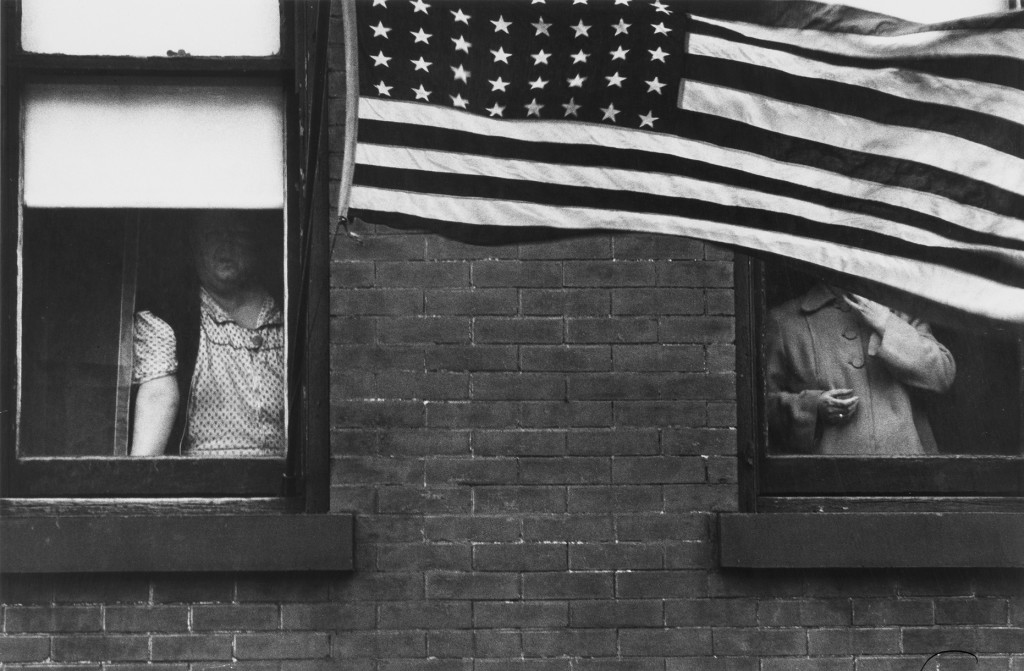Looking closely: What is so special about the photography “Parade Hoboken” from Robert Frank?

Parade Hoboken, 1955, New Jersey, from looking in: Robert Frank’s The Americans published by Steidl. Photograph: Robert Frank/Steidl
Although Robert Franks’ photos later became “American classics” and Icons of American Photography” that was not exactly the case when the photo book “The Americans” was published the first time in America in 1959. The reactions on his photos went from “A sad poem by a sick person” (as quoted by NPR) to “wart-covered” or “warped” (New York Times). But why was that?
To find out we are going to have a close look to one of the most famous photos of “The Americans”: “Parade Hoboken” which Frank captured in New Jersey in 1955/56 during his two years journey through the American States on his Guggenheim fellowship. The photo is a picture in a picture: We see two women each of them framed by a window. We do not see there faces. The face of the one in the left window is swallowed by the room’s darkness, her mouth is nearly blurred out. We just know it is there because it must be there. The face of the women on the right is covered completely by the asymmetric stripes of the American flag. She can’t neither see the photographer nor can she see much of the parade, nor does she care or move an inch to do something against it. It seems as if she is closing up her coat, her left hand looks like a claw which is irritating. Maybe she is leaving soon for the parade. Also the women in the left window is irritating in a way because we cannot see her face and her mouth is blurred out. Apparently she is wears her house dress which does not look like she would go out to join the parade. Both of them are not individualized, we don’t see any individual streak. In contrast to the American banner the bricks in the wall repeat themselves in an imperfect manner. The American flag is cut off to the half. We see some stars on the banner but not all of them.
But it is actually due to the flag that we assume this to be a patriotic event. It’ s the only object in the photo which refers to an official act – apart from the title. Given that this is apparently a national holiday parade, what Robert Franks shows us here has not much to do with what we would assume to be a celebrated, national event: What we see is two women looking out the window and being prevented from doing so by the American flag. In opposition to what the caption says, we in fact are NOT seeing much of the parade. We see tristesse and certainly not what is known as sharing the American dream. Ed Ruscha, at that time a young artist, said about the book: “I’d never seen anything like it. Robert Frank came out here and he just showed that you could see USA until you spit blood.” In fact critics would say that the pictures are asymmetrical and blurred. A fact that to an eye which was used to see sharp and perfect photos in magazines was difficult to handle. According to Robert Frank the Museum of Modern Art even refused to sell the book.
But there was a young generation. The generation of Ed Ruscha who got inspired deeply by Frank’s book and who appreciated it for showing a completely new approach to photography as Ed Ruscha says: “It’s like – You know where you were when John F. Kennedy was shot? I know where I was when I saw ‘The Americans’ […] I was aware of Walker Evans’ work. But I felt like those were still lives. Robert’s work was life in motion.” This life in motion and this new look on things was perfectly captured in Jack Kerouac’s introduction for “The Americans”. Kerouac had just published his famous book “On the road” and was praised by critics. Robert Frank read the book, found out that they had in common “the love of America”. It was Frank who asked Kerouac if he could write the introduction to “The Americans”. “Sure, I can write something”, was the reply.
What is so special about Franks’ photos is that he realized things and NOT looked away from them. Robert Frank says about his images: “I photographed people who were held back […] My sympathies were with people who struggled. There was also my mistrust of people who made the rules.” His wife describes this ability of taking photos: “It’s ‘What’s going on here?’ None of us know until he takes a photograph…” It is exactly in this way that Robert Frank chose to question the American Dream and to make people reflect on society and its rules. He does not turn away from what other people do not want to see.
All direct quotes are taken from the very, very good article about Robert Frank in the New York Times.
